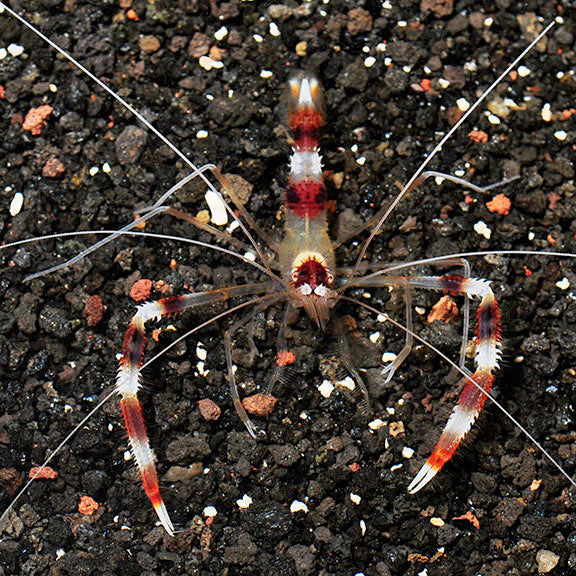Coral Farm Kuwait
Boxing Shrimp - Stenopus hispidus
Boxing Shrimp - Stenopus hispidus
لم نتمكن من تحميل توفر الاستلام
جمبري الشعاب المرجانية المخطط (Banded Coral Shrimp) يلفت أنظار معظم هواة الأحواض البحرية بفضل ألوانه الزاهية وشكل جسمه المميز. يتميز بخطوط حمراء وبيضاء لافتة للنظر تمتد على جسمه مع مخالب طويلة نسبياً وهوائيات بيضاء طويلة جداً. ومع ملمسه الشوكي، يضفي هذا العضو المسالم من عائلة Stenopodidae لمسة جمالية على أي حوض بحري. ومع ذلك، يشيد معظم الهواة بنشاط Stenopus hispidus المستمر أثناء تجواله في الحوض بحثاً عن الطعام.
ومن المثير للاهتمام أن أعضاء عائلة Stenopodidae يُعرفون باسم "جمبري الملاكمة" بسبب المخالب الكبيرة على الزوج الثالث من أرجلهم، حيث تُرفع هذه المخالب للأعلى مما يمنح جمبري الشعاب المرجانية المخطط مظهر الملاكم الجاهز للقتال. وعلى الرغم من أن هذا الجمبري قد يكون عدائياً تجاه جمبري الشعاب المرجانية المخطط الآخر أو الجمبري الأصغر من أنواع مختلفة، إلا أنه غالباً ما يكون مسالماً تجاه الأسماك والشعاب المرجانية واللافقاريات الأخرى في الحوض. ونظراً لطباعه العدائية تجاه أبناء نوعه، يُنصح بالاحتفاظ بجمبري الشعاب المرجانية المخطط بمفرده أو كزوج متزاوج حقيقي فقط.
موطنه الأصلي محيطات إندونيسيا، ويُعد Stenopus hispidus على الأرجح أكثر أنواع الجمبري انتشاراً في البحر. عادة ما يتدلّى رأساً على عقب داخل الكهوف أو الشقوق مع بروز هوائياته فقط من الفتحة. أثناء عملية الانسلاخ، يختبئ جمبري الشعاب المرجانية المخطط عادة لمدة يوم إلى يومين بين الصخور في الشعاب المرجانية. وفي الحوض المنزلي، يجب توفير مساحة كافية له ليتحرك بحرية دون أن تلامس هوائياته الطويلة الشعاب المرجانية أو شقائق النعمان المجاورة.
يُعد جمبري الشعاب المرجانية المخطط قوي التحمل نسبياً ويصل طوله المناسب للأحواض إلى 3 بوصات فقط، و6 بوصات عند احتساب الهوائيات. عادة ما يكون الذكر أصغر حجماً. ويُعد تكاثر جمبري الشعاب المرجانية المخطط في الأسر غير ناجح في الغالب، حيث تموت اليرقات عادة بسبب أنظمة الترشيح والكشط في الحوض.
وكغيره من اللافقاريات، لا يتحمل جمبري الشعاب المرجانية المخطط مستويات مرتفعة من النترات أو النحاس. تأكد من الحفاظ على مستويات مناسبة من اليود في الحوض لضمان انسلاخ صحي. ويجب تكييف جمبري الشعاب المرجانية المخطط ببطء لتجنب أي صدمة في الملوحة أو الأس الهيدروجيني (pH).
في البرية، يُعد جمبري الشعاب المرجانية المخطط من القُمّامين، أما في الحوض المنزلي فسوف يتقبل معظم الأطعمة المجففة والمجمدة.
The Banded Coral Shrimp catches the eyes of most aquarists with their beautiful coloration and body shape. It has striking red and white bands across its body with fairly long pinchers and extra long white antennae. Combined with its prickly body texture, this peaceful member of the Stenopodidae family brings interest to any marine aquarium. However, most hobbyists praise Stenopus hispidus for its active nature as it scampers around the aquarium in search of food.
Interestingly, members of the Stenopodidae family are known as "Boxing Shrimp" because of the large pinchers on their third set of legs. These pinchers are often held erect and give the Banded Coral Shrimp the appearance of a boxer ready to fight. Though the Banded Coral Shrimp can be aggressive towards other Banded Coral Shrimp and smaller shrimp of different species, most are peaceful towards fish, corals, and invertebrates within your aquarium. Because of its aggressive disposition towards other Banded Coral Shrimp, the Banded Coral Shrimp should be housed individually or kept as a true mated pair.
Native to the oceans of Indonesia, Stenopus hispidus is perhaps the most widely distributed shrimp in the sea. It usually hangs upside-down in caves or crevices, with only its antennae emerging from the hole. While molting, the Banded Coral Shrimp will often hide from sight for 1-2 days in the rocks of the reef. In the home aquarium, provide sufficient room for the Banded Coral Shrimp so it can move about freely without its long antennae touching neighboring corals or anemones.
The Banded Coral Shrimp is relatively hardy and boasts an aquarium-suited length that rarely exceeds 3 inches, 6 inches with the antennae. The male Banded Coral Shrimp is usually smaller. Breeding the Banded Coral Shrimp is usually not successful. Larvae generally succumb to filtration and skimming.
Like other invertebrates, the Banded Coral Shrimp is intolerant of high nitrate or copper levels. Be sure to maintain proper iodine levels in the aquarium to help ensure proper molting. The Banded Coral Shrimp must be acclimated slowly to avoid any salinity and/or pH shock.
In the wild, the Banded Coral Shrimp is a scavenger. In the home aquarium, it will accept most flaked and frozen foods.
يشارك


